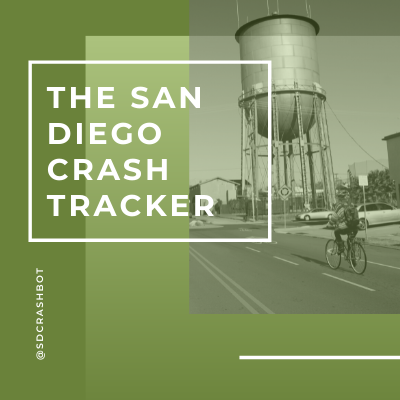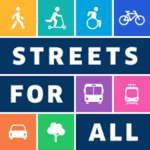This week, with support from Eric Dasmalchi, the Los Angeles mobility advocacy organization Streets for All, and Citizen App, we’re launching a Twitter program that will automatically report the details of every pedestrian and bicyclist-involved crash in San Diego in real time. Follow @SDCrashBot on Twitter to see the reports, or read on to learn more about this program, and why we think it is an extremely important and overdue tool in the fight for safe streets in San Diego.
We’ve long had data to show that San Diego’s roads are dangerous; from 2016 to 2020, an average of 242 people walking, and 80 people riding bikes, were killed or seriously injured on the streets of San Diego County each year. If any other activity or part of our infrastructure killed and maimed this many people per year, we would expect immediate and decisive action from our governments to reduce harm.
Yet for decades, despite consistently high deaths and injuries, government officials have made minimal concessions to road safety, instead choosing to accept this deluge of death and suffering as the inevitable cost of a fast transportation system. That tradeoff between speed and safety is a false and harmful dichotomy; Cities around the world that have chosen to treat traffic violence as a preeminent public health issue have successfully cut road fatalities by over 80% by implementing a basic set of safe road design standards.
While in 2015, the City of San Diego made a major step forward by adopting Vision Zero, or a commitment to reach zero traffic fatalities by 2025, the speed at which our roads are being upgraded for safety has not matched the urgency of over 300 people being killed or maimed each year.
One problem for advocates in communicating the urgency of road safety improvements has been our inability to match the emotional potency of recent crashes with up-to-date data. California’s main crash-tracking program, SWITRS (California Statewide Integrated Traffic Records System), and its mapping program, TIMS (Transportation Injury Mapping System) don’t report definitive crash statistics until almost two years after the fact. That delay prevents us from linking high-profile, fatal crashes with the many other lower-profile crashes that invariably occur at the same location. Furthermore, SWITRS and TIMS only publish data on crashes for which a complaint of pain was reported, obscuring the many crashes in which serious injury was narrowly avoided.
Our real-time crash tracking program will transform the crash-reporting process. Our program relies upon data from the Citizen App, an application that monitors police scanners and reports on incidents in real-time, to tweet out the rough details and locations of crashes as soon as they occur. While this methodology won’t catch the many crashes in which police aren’t called at all, it dramatically increases our knowledge of crashes happening on a daily basis, and allows us to understand how many crashes occur in which no one is hurt. Every collision between a motor vehicle and cyclist or pedestrian has the potential for serious injury or death, so it’s essential to understand where every crash is happening.
This program shouldn’t be used as a substitute for the official statistics published through SWITRS and TIMS– police scanner reports don’t capture what happens after a crash, and aren’t fact-checked for accuracy. If someone dies or develops serious injuries days after a crash, for example, this program won’t depict that. Yet those tragedies are the crashes that typically make the news already, and this program will allow us to link them with the countless ignored near-tragedies that invariably occur on the same, unsafe roads.
The injuries and deaths on San Diego’s roads are a public health crisis that we’ve known about for decades. We hope this tool will help our elected officials and traffic engineers understand traffic violence as the ongoing public health emergency that it has always been.
Thank you to Eric Dasmalchi and Streets for All for helping us launch this program! To support the Crash Tracker, donate to the San Diego County Bike Coalition.



